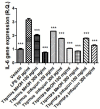New Biological and Chemical Evidences of Two Lamiaceae Species (Thymbra capitata and Thymus sipyleus subsp. rosulans): In Vitro, In Silico and Ex Vivo Approaches
- PMID: 36558163
- PMCID: PMC9784812
- DOI: 10.3390/molecules27249029
New Biological and Chemical Evidences of Two Lamiaceae Species (Thymbra capitata and Thymus sipyleus subsp. rosulans): In Vitro, In Silico and Ex Vivo Approaches
Abstract
In this study, the methanolic and infusion extracts of two species, Thymbra capitata and Thymus sipyleus subsp. rosulans, were tested for their chemical composition and biological abilities (antioxidant, enzyme inhibitory and anti-inflammatory effects). The extracts yielded total phenolic and flavonoid contents in the range of 83.43-127.52 mg GAE/g and 9.41-46.34 mg RE/g, respectively. HPLC analysis revealed rosmarinic acid to be a major component of the studied extracts (15.85-26.43%). The best ABTS radical scavenging ability was observed in the methanol extract of T. capitata with 379.11 mg TE/g, followed by in the methanol extract of T. sipylus (360.93 mg TE/g). In the CUPRAC assay, the highest reducing ability was also found in the methanol extract of T. capitata with 802.22 mg TE/g. The phosphomolybdenum ability ranged from 2.39 to 3.61 mmol TE/g. In terms of tyrosinase inhibitory effects, the tested methanol extracts (83.18-89.66 mg KAE/g) were higher than the tested water extracts (18.74-19.11 mg KAE/g). Regarding the BChE inhibitory effects, the methanol extracts were active on the enzyme while the water extracts showed no inhibitory effect on it. Overall, the methanolic extracts showed better enzyme inhibition compared to the infusion extracts. Molecular docking also showed the selected exhibited potential binding affinities with all enzymes, with a preference for cholinesterases. Additionally, the extracts were effective in attenuating the LPS-induced increase in COX-2 and IL-6 gene expression in isolated colon, thus indicating promising anti-inflammatory effects. The preliminary results of this study suggest that these species are good natural sources of antioxidants and also provide some scope as enzyme inhibitors, most likely due to their bioactive contents such as phenolic acids, and thus can be exploited for different applications related to health promotion and disease prevention.
Keywords: Thymbra capitata; Thymus sipyleus subsp. rosulans; anti-inflammatory; antioxidant; enzyme inhibitors; flavonoid; phenolic.
Conflict of interest statement
The authors declare no conflict of interest.
Figures




Similar articles
-
Chemical Characterization and Multidirectional Biological Effects of Different Solvent Extracts of Arum elongatum: in Vitro and in Silico Approaches.Chem Biodivers. 2023 Apr;20(4):e202201181. doi: 10.1002/cbdv.202201181. Epub 2023 Mar 22. Chem Biodivers. 2023. PMID: 36891864
-
Scrophularia lucida L. as a valuable source of bioactive compounds for pharmaceutical applications: In vitro antioxidant, anti-inflammatory, enzyme inhibitory properties, in silico studies, and HPLC profiles.J Pharm Biomed Anal. 2019 Jan 5;162:225-233. doi: 10.1016/j.jpba.2018.09.035. Epub 2018 Sep 18. J Pharm Biomed Anal. 2019. PMID: 30268023
-
Deeper Insights on Alchornea cordifolia (Schumach. & Thonn.) Müll.Arg Extracts: Chemical Profiles, Biological Abilities, Network Analysis and Molecular Docking.Biomolecules. 2021 Feb 4;11(2):219. doi: 10.3390/biom11020219. Biomolecules. 2021. PMID: 33557215 Free PMC article.
-
Which Extraction Solvents and Methods Are More Effective in Terms of Chemical Composition and Biological Activity of Alceafasciculiflora from Turkey?Molecules. 2022 Aug 6;27(15):5011. doi: 10.3390/molecules27155011. Molecules. 2022. PMID: 35956963 Free PMC article. Review.
-
Health-Promoting Effects of Thymus Phenolic-Rich Extracts: Antioxidant, Anti-Inflammatory and Antitumoral Properties.Antioxidants (Basel). 2020 Sep 1;9(9):814. doi: 10.3390/antiox9090814. Antioxidants (Basel). 2020. PMID: 32882987 Free PMC article. Review.
Cited by
-
Comparative GC-MS Analysis of Fresh and Dried Curcuma Essential Oils with Insights into Their Antioxidant and Enzyme Inhibitory Activities.Plants (Basel). 2023 Apr 27;12(9):1785. doi: 10.3390/plants12091785. Plants (Basel). 2023. PMID: 37176843 Free PMC article.
-
Evaluating Phytochemical Profiles, Cytotoxicity, Antiviral Activity, Antioxidant Potential, and Enzyme Inhibition of Vepris boiviniana Extracts.Molecules. 2023 Nov 10;28(22):7531. doi: 10.3390/molecules28227531. Molecules. 2023. PMID: 38005252 Free PMC article.
-
A Comparative Study on UHPLC-HRMS Profiles and Biological Activities of Inula sarana Different Extracts and Its Beta-Cyclodextrin Complex: Effective Insights for Novel Applications.Antioxidants (Basel). 2023 Oct 10;12(10):1842. doi: 10.3390/antiox12101842. Antioxidants (Basel). 2023. PMID: 37891923 Free PMC article.
-
Essential Oils Composition and Biological Activity of Chamaecyparis obtusa, Chrysopogon nigritanus and Lavandula coronopifolia Grown Wild in Sudan.Molecules. 2023 Jan 19;28(3):1005. doi: 10.3390/molecules28031005. Molecules. 2023. PMID: 36770673 Free PMC article.
-
Comparative Study on the Chemical Profile, Antioxidant Activity, and Enzyme Inhibition Capacity of Red and White Hibiscus sabdariffa Variety Calyces.ACS Omega. 2023 Oct 30;8(45):42511-42521. doi: 10.1021/acsomega.3c05217. eCollection 2023 Nov 14. ACS Omega. 2023. PMID: 38024777 Free PMC article.
References
-
- Carović-StanKo K., PeteK M., Grdiša M., Pintar J., Bedeković D., Satovic Z. Medicinal plants of the family Lamiaceae as functional foods—A review. Czech J. Food Sci. 2016;34:377–390. doi: 10.17221/504/2015-CJFS. - DOI
-
- Chakrabartty I., Mohanta Y.K., Nongbet A., Mohanta T.K., Mahanta S., Das N., Saravanan M., Sharma N. Exploration of Lamiaceae in Cardio Vascular Diseases and Functional Foods: Medicine as Food and Food as Medicine. Front. Pharmacol. 2022;13:894814. doi: 10.3389/fphar.2022.894814. - DOI - PMC - PubMed
-
- Elbouny H., Ouahzizi B., El-guourrami O., Drioua S., Mbarek A.N., Sellam K., Alem C. Chemical profile and biological properties of the essential oil of Thymus atlanticus (Ball) Roussine. S. Afr. J. Bot. 2022;151:475–480. doi: 10.1016/j.sajb.2022.10.028. - DOI
MeSH terms
Substances
LinkOut - more resources
Full Text Sources
Research Materials
Miscellaneous

